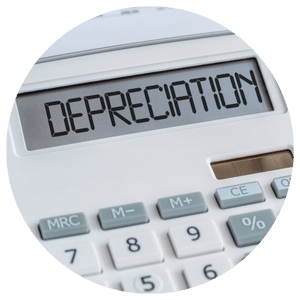Written By: MB Group
If you run a business, chances are you've got some assets—whether they're physical things like equipment or more intangible like patents. Now, when it comes to figuring out their value over time, this is where amortization and depreciation come into play. These two methods help determine the gradual decrease in value of different types of assets. While they may sound similar, there are key differences in how they are applied, what factors are considered, and how they are reflected in your financial statements. Let's dive into these concepts to help you better manage your company's assets.
At its core, depreciation is about recognizing the wear and tear on your business's tangible assets as they age. From the machinery humming in your production line to the sturdy buildings housing your operations, it's like acknowledging that, just like your favorite pair of sneakers, your assets are getting a bit worn out.
assets as they age. From the machinery humming in your production line to the sturdy buildings housing your operations, it's like acknowledging that, just like your favorite pair of sneakers, your assets are getting a bit worn out.
Fixed assets, the stars of depreciation, are tangible objects your business acquires—buildings, equipment, office furniture, vehicles, and machinery. Unlike their intangible counterparts, these assets might still hold value even when your business is done using them.
Depreciation isn't just a financial term; it's a practical way of acknowledging and accounting for the natural aging process of the assets that keep your business ticking.
Now, not all things depreciate in the same way. The most common methods of depreciation are:
 Amortization, on the other hand, serves as a strategic practice that involves systematically allocating the cost of an intangible asset over its anticipated useful life. Intangible assets, characterized by their non-physical nature, hold intrinsic value for businesses. These assets can take various forms, including patents, trademarks, franchise agreements, copyrights, and the costs associated with issuing bonds or organizational endeavors.
Amortization, on the other hand, serves as a strategic practice that involves systematically allocating the cost of an intangible asset over its anticipated useful life. Intangible assets, characterized by their non-physical nature, hold intrinsic value for businesses. These assets can take various forms, including patents, trademarks, franchise agreements, copyrights, and the costs associated with issuing bonds or organizational endeavors.
The essence of amortization lies in its meticulous approach to recognizing the enduring value of intangible assets. Rather than treating these assets as a one-time expense, amortization spreads their cost over time, reflecting the gradual expiration or diminishing value that these intangible treasures may undergo. This process aligns with the financial principle of accurately representing the contributions of assets to a business over their useful life.
The common practice in amortization typically involves allocating the expense on a straight-line basis. In simpler terms, an equal amount is expensed in each accounting period throughout the asset's expected useful life. This method not only simplifies financial management but also provides businesses with a clear and steady approach to recognizing the ongoing value of their intangible assets.
As a business owner, the recognition and understanding of depreciation and amortization extend beyond mere accounting principles; they become pivotal tools in strategic financial management. Here's why business owners should care deeply about these concepts:
Depreciation and amortization provide invaluable insights for financial planning and budgeting. By systematically allocating the costs of tangible and intangible assets over time, business owners can anticipate future expenses, enabling more accurate budget forecasts. This, in turn, facilitates informed decision-making regarding resource allocation and investment strategies.
Understanding depreciation and amortization is crucial for navigating tax implications effectively. Both methodologies can influence taxable income, with depreciation often providing businesses with tax deductions based on the gradual wear and tear of tangible assets. For business owners, leveraging these deductions strategically can optimize tax liabilities and enhance overall financial efficiency.
Properly managing depreciation and amortization ensures a realistic representation of the value of business assets over their useful life. This, in turn, contributes to accurate financial reporting and transparent disclosure. Business owners can use this information to assess the actual value of their assets, aiding in negotiations, financial disclosures, and potential sales or acquisitions.
Depreciation and amortization play a pivotal role in strategic decision-making. Business owners armed with a clear understanding of the gradual decrease in asset values can make informed choices about when to repair, replace, or upgrade assets. This foresight enhances operational efficiency, minimizes downtime, and supports the overall longevity of the business.
Adhering to accounting standards and regulations is a non-negotiable aspect of responsible business management. By incorporating proper depreciation and amortization practices, business owners ensure compliance with accounting standards, fostering transparency and accountability in financial reporting. This, in turn, builds credibility with stakeholders, including investors, lenders, and regulatory bodies.
In essence, depreciation and amortization are not just abstract accounting concepts; they are powerful tools that empower business owners to navigate financial complexities, optimize tax strategies, make informed decisions, and uphold transparency in financial reporting. Recognizing the long-term impact of these practices is fundamental for fostering financial resilience and ensuring the sustained success of any business venture, and the MB Group team is here to help. Contact our team today to get started.
Tags: Businesses
SBA Economic Injury Loans The U.S. Small Business Administration is offering low-interest federal disaster loans for working capital to small businesses suffering substantial economic injury as a...
Read MoreArtificial intelligence (AI) has entered the accounting world with undeniable force, offering possibilities for streamlining processes and enhancing financial decision-making. While it's important to...
Read MoreTransaction costs don’t always make headlines, but they can move the numbers in ways that matter. Buying a new asset, restructuring debt, or chasing a merger? The way you account for those costs,...
Read More